Hailuoto
Karlö | |
|---|---|
Municipality | |
| Hailuodon kunta Karlö kommun | |
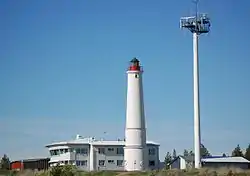 Pilot station and lighthouse in Marjaniemi | |
 Coat of arms | |
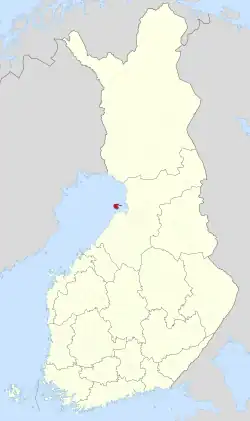 Location of Hailuoto in Finland | |
| Coordinates: 65°01′N 024°43′E / 65.017°N 24.717°E | |
| Country | |
| Region | North Ostrobothnia |
| Sub-region | Oulu |
| Government | |
| • Municipal manager | Ari Nurkkala |
| Area (2018-01-01)[1] | |
| • Total | 1,082.70 km2 (418.03 sq mi) |
| • Land | 205.65 km2 (79.40 sq mi) |
| • Water | 882.17 km2 (340.61 sq mi) |
| • Rank | 261st largest in Finland |
| Population (2023-09-30)[2] | |
| • Total | 951 |
| • Rank | 296th largest in Finland |
| • Density | 4.62/km2 (12.0/sq mi) |
| Population by native language | |
| • Finnish | 98.1% (official) |
| • Others | 1.9% |
| Population by age | |
| • 0 to 14 | 12.8% |
| • 15 to 64 | 48.4% |
| • 65 or older | 38.9% |
| Time zone | UTC+02:00 (EET) |
| • Summer (DST) | UTC+03:00 (EEST) |
| Website | www |
| Official name | Bird Wetlands of Hailuoto Island |
| Designated | 2 February 2004 |
| Reference no. | 1505[5] |
Hailuoto (Finnish: [ˈhɑi̯ˌluo̯to]; Swedish: Karlö) is a Finnish island in the northern Baltic Sea and a municipality in Northern Ostrobothnia region. The population of Hailuoto is 951 (September 30, 2023),[2] making it the smallest municipality in Northern Ostrobothnia and the former Oulu Province in terms of population. The municipality covers an area of 205.65 km2 (79.40 sq mi) (excluding sea areas) of which 1.70 km2 (0.66 sq mi) is inland water (January 1, 2018).[1] The population density is 4.62/km2 (12.0/sq mi). Of all the Finnish sea islands, Hailuoto is the third largest after Fasta Åland and Kimitoön.[6]
Hailuoto lies opposite the city of Oulu in the Gulf of Bothnia. The distance between Oulu and Hailuoto is 53 kilometres (33 mi), and the sea area between them is called Luodonselkä (literally "open water of the islet").[7]
Land in the region is constantly rising due to post-glacial rebound. It is estimated that the first parts of Hailuoto appeared from the Baltic Sea about 1700 years ago. The current island of Hailuoto was formed from many smaller islands. Two large sections, Santonen and Hanhinen merged into the main island (Luoto) only about two centuries ago. The island is continuously expanding and eventually it will join with the continent. Kirkkosalmi, a wetland region between Hanhinen and Luoto is renowned for being an important bird refuge where rare bird species are observed.
The theme of the coat of arms of Hailuoto describes the economy of the island municipality; the explanation of the coat of arms is "in a blue field with a silver rowlock." The coat of arms was designed by Teuvo-Pentti Pakkala and approved by the Hailuoto Municipal Council at its meeting on 28 April 1966. The Ministry of the Interior approved the use of the coat of arms on 19 December of the same year.[8][9]
History
The permanent settlement of Hailuoto apparently began in the 12th century. Residents came from many directions, especially from Karelia. The Swedes, who competed for its fishing waters, gave the island the name Karelö (which was transformed into Karlö), which means freely translated "Karelian Island". The first permanent residents of Hailuoto were mostly from Western Finland, but some also came from Eastern Finland. In 1548 there were 43 houses on the island, and by 1570 the number of houses had grown to 60. Queen Christina of Sweden donated the entire island of Hailuoto in 1652 to Colonel Berndt Taube, from whose heirs it was returned to the crown in 1675.[10]
Hailuoto first belonged to the high parish of Saloinen (nowadays part of Raahe), from which it separated into an independent parish in 1587.[11][12] The church, built in 1610–1620, was for a long time the oldest wooden church in use in Finland until it burned down in 1968.[13] The current church was completed in 1972.[14]
During the Great Famine of 1695–1697, 88 inhabitants of Hailuoto died.[10] During the Great Northern War (1713–1721), 200 Cossacks of the Tsardom of Russia killed about 800 people in Hailuoto with axes on 29 September 1714. Many of the victims had sought protection on the island, as Hailuoto had a population of less than 300 at that time. The bloodshed done overnight was the greatest of the Great Northern War.[15] According to tradition, the bells of Hailuoto Church were drowned in Lake Kirkonjärvi during the Great Northern War, where they were never found again.[10]
Geography and nature
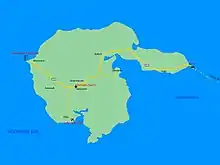
Hailuoto is the largest island in the Gulf of Bothnia, consisting of four parts, Luoto, Santonen, Hanhinen and Syökari. They were still separated a couple of centuries ago until they joined together as a result of crustal rebound. The young surface forms of the island are shaped throughout by sea waves, currents, ice thrust and wind.[13]
The soil consists of sandy materials, which are partly derived from clay sandstone, which is called The formation of Muhos extends to Hailuoto. A 15-kilometer-long grayling ridge runs through the island from Hyypänmäki to Marjaniemi in a north-east-southwest direction. In the eastern parts of Hyypänmäki, the meltwater of the glacier has broken up the sand into a plateau almost two kilometers wide. In the central parts, Harju runs only a few ten-meter-wide high ridges, but spreads west from Isomäki again. The quarry Marjaniemi tip is a wear residue of the heart of the ridge. The highest point is Hyypänmäki which is about 31 meters above sea level. There are also rocks in the Hyypänmäki area, which are later covered with dry quicksand. The rocks show that the waves washed the shores of the islands, but the cliff ramparts also show that the drift ice pushed violently against the shores. Aerial sand dikes and shore dikes are a special feature that characterizes the surface forms of Hailuoto, especially on the north and west coasts.[13]
The most diverse part of Hailuoto's vegetation is spread on the shores, especially in the coastal meadows of sheltered coves. In forest nature, dry pine barrens are well represented. Extensive lichen fabrics are particularly characteristic. Hailuoto, a bird research site, has a long tradition. Waterfowl are most abundant in meadows, extensive shallows, reefs and lush bays. The highlight of the fall is the migration of swans, which culminates in one and a half thousand birds resting on the shores.[13]
In November 2019, a rare phenomenon was observed on the shores of Marjaniemi in Hailuoto, when thousands of "egg-shaped" sea ice had accumulated on the shore.[16][17][18] BBC Weather expert George Goodfellow explained the reason for the phenomenon: "The general picture is that they form from pieces of larger ice sheet which then get jostled around by waves, making them rounder. They can grow when sea water freezes on to their surfaces and this also helps to make them smoother. So the result is a ball of smooth ice which can then get deposited on to a beach, either blown there or getting left there when the tide goes out."[18]
Islands
- Hailuoto (main island)
- Hoikanriisi
- Isomatala
- Kengänkari
- Mustakivi
- Santosenkari
- Pikku-Hoikka
- Ulkoriisi
- Ulkolaidanmatala
- Väliteonkarit
Villages
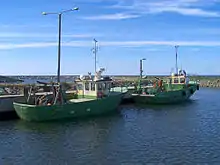
- Järventakusta
- Hailuoto
- Koivukylä
- Marjaniemi
- Ojakylä
- Pöllä
- Ulkokarvo
- Vaski
Climate
Hailuoto has a subarctic climate (Dfc). The climate is slightly milder than Oulu's due to influence from the Bothnian Bay.
| Climate data for Hailuoto Keskikylä (1991–2020 normals, extremes 1959- present) | |||||||||||||
|---|---|---|---|---|---|---|---|---|---|---|---|---|---|
| Month | Jan | Feb | Mar | Apr | May | Jun | Jul | Aug | Sep | Oct | Nov | Dec | Year |
| Record high °C (°F) | 6.5 (43.7) |
6.0 (42.8) |
11.3 (52.3) |
19.4 (66.9) |
28.5 (83.3) |
30.7 (87.3) |
32.8 (91.0) |
30.9 (87.6) |
23.6 (74.5) |
16.5 (61.7) |
11.0 (51.8) |
6.8 (44.2) |
32.8 (91.0) |
| Mean daily maximum °C (°F) | −4.3 (24.3) |
−4.8 (23.4) |
−0.8 (30.6) |
4.9 (40.8) |
11.8 (53.2) |
17.1 (62.8) |
20.3 (68.5) |
18.4 (65.1) |
12.9 (55.2) |
6.1 (43.0) |
1.3 (34.3) |
−1.9 (28.6) |
6.8 (44.2) |
| Daily mean °C (°F) | −7.6 (18.3) |
−8.2 (17.2) |
−4.5 (23.9) |
1.0 (33.8) |
7.2 (45.0) |
12.8 (55.0) |
16.1 (61.0) |
14.3 (57.7) |
9.5 (49.1) |
3.7 (38.7) |
−0.8 (30.6) |
−4.5 (23.9) |
3.3 (37.9) |
| Mean daily minimum °C (°F) | −11.4 (11.5) |
−12.2 (10.0) |
−8.5 (16.7) |
−2.9 (26.8) |
2.3 (36.1) |
8.0 (46.4) |
11.2 (52.2) |
9.7 (49.5) |
5.6 (42.1) |
0.8 (33.4) |
−3.4 (25.9) |
−7.8 (18.0) |
−0.7 (30.7) |
| Record low °C (°F) | −37.3 (−35.1) |
−40.8 (−41.4) |
−31.1 (−24.0) |
−23.0 (−9.4) |
−10.5 (13.1) |
−3.3 (26.1) |
0.8 (33.4) |
−2.6 (27.3) |
−7.8 (18.0) |
−19.6 (−3.3) |
−31.3 (−24.3) |
−36.8 (−34.2) |
−40.8 (−41.4) |
| Average precipitation mm (inches) | 37 (1.5) |
31 (1.2) |
30 (1.2) |
27 (1.1) |
39 (1.5) |
45 (1.8) |
61 (2.4) |
56 (2.2) |
53 (2.1) |
53 (2.1) |
50 (2.0) |
42 (1.7) |
523 (20.6) |
| Average precipitation days | 10 | 8 | 8 | 6 | 7 | 8 | 9 | 9 | 8 | 10 | 11 | 11 | 105 |
| Source 1: FMI climatological normals for Finland 1991-2020[19] | |||||||||||||
| Source 2: Record highs and lows 1959- present[20] | |||||||||||||
Services
In the center village of Hailuoto there is a comprehensive school,[21] two grocery stores (K-Market and Sale), a bank (Osuuspankki), a barber shop and a filling station (SEO).[22]
The Arctic Light House Hotel for tourists is located right next to the Marjaniemi Lighthouse.[23]
Religion
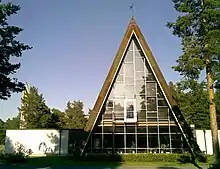
According to the 2018 regional division, the only parishes in the municipality are the Hailuoto Parish of the Finnish Evangelical Lutheran Church[24] and the Oulu Orthodox Parish of the Finnish Orthodox Church.[25] Of the revival movements within the church, Conservative Laestadianism operates in the locality, which has the Hailuoto Peace Association (Hailuodon Rauhanyhdistys).[26]
Culture
The entire island of Hailuoto is classified as one of Finland's nationally significant built cultural environments.[27] The unique landscape and natural conditions have made Hailuoto, the largest island in the Bay of Bothnia, one of Finland's national landscapes.
Food
In the 1980s, fish potatoes made from European whitefish were named traditional food of the Hailuoto parish.[28]
Transportation
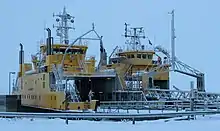
A ferry operates regularly between Hailuoto and Oulu's suburb of Oulunsalo. In winter an official ice road, approximately 10 kilometres (6.2 mi) long, connects the island to the mainland.[29] The main road on the island is the regional road 816, which continue to the mainland towards the Kempele municipality via a ferry connection. Hailuoto also has a small airfield, Hailuoto Airfield, about 6 kilometres (4 mi) south of central village.[30]
A 8.4 km fixed link to connect Hailuoto to the mainland, consisting of a causeway with two 750 m bridges, was approved in 2015.[31] Due to environmental litigation, as of 2022 construction has yet to start.[32]
Notable people
- Henry Askeli (1886–1962), Finnish American journalist and labor activist
- Yrjö Karilas (1891–1982), writer
See also
References
- 1 2 "Area of Finnish Municipalities 1.1.2018" (PDF). National Land Survey of Finland. Retrieved 30 January 2018.
- 1 2 "Preliminary population statistics 2023, September". StatFin. Statistics Finland. Retrieved 26 October 2023.
- ↑ "Demographic Structure by area as of 31 December 2022". Statistics Finland's PX-Web databases. Statistics Finland. Retrieved 6 September 2023.
- ↑ "Population according to age (1-year) and sex by area and the regional division of each statistical reference year, 2003–2020". StatFin. Statistics Finland. Retrieved 2 May 2021.
- ↑ "Bird Wetlands of Hailuoto Island". Ramsar Sites Information Service. Retrieved 25 April 2018.
- ↑ "Suomen merialueiden sata suurinta saarta" (in Finnish). Suomen Kuvalehti. 15 June 1987. p. 64.
{{cite magazine}}: Cite magazine requires|magazine=(help) - ↑ Facta 2001, WSOY, 1984 (in Finnish)
- ↑ Suomen kunnallisvaakunat (in Finnish). Suomen Kunnallisliitto. 1982. p. 129. ISBN 951-773-085-3.
- ↑ "Sisäasiainministeriön vahvistamat kaupunkien, kauppaloiden ja kuntien vaakunat 1949-1995 I:8 Hailuoto". Kansallisarkiston digitaaliarkisto (in Finnish). Retrieved 15 March 2021.
- 1 2 3 Hannu Tarmio, Pentti Papunen & Kalevi Korpela: Suomenmaa 1: maantieteellis-yhteiskunnallinen tieto- ja hakuteos, p. 217–220. Porvoo-Helsinki: WSOY, 1967. (in Finnish)
- ↑ Hailuodon historia – Luontoon (in Finnish)
- ↑ Paimenmuisto: Hailuoto (Carlö, Karlö) – Kansallisbiografia (in Finnish)
- 1 2 3 4 Kalevi Rikkinen (1986). Finlandia, Otavan iso maammekirja 8 (in Finnish). Helsinki: Otava. ISBN 951-1-09142-5.
- ↑ "Hailuodon seurakunta Hiski-tietokannassa" (in Finnish). Retrieved 8 January 2021.
- ↑ Kaitasuo, Pia (15 August 2015). "Pietari Suuren synkkä tuhon kylvö". Kaleva (in Finnish). No. 221. Oulu: Kaleva Oy. pp. 34–35. ISSN 0356-1356.
- ↑ Hintsala, Juha (4 November 2019). "Jäiset "kananmunat" hämmästyttivät sunnuntaikävelijöitä Hailuodossa – harvinainen luonnonilmiö vaatii juuri oikeat olosuhteet syntyäkseen". YLE (in Finnish). Retrieved 20 March 2022.
- ↑ Murray, Jessica (7 November 2019). "Thousands of rare 'ice eggs' found on beach in Finland". The Guardian. Retrieved 20 March 2022.
- 1 2 "'Ice eggs' cover Finland beach in rare weather event". BBC. 7 November 2019. Retrieved 20 March 2022.
- ↑ "FMI normals 1991-2020" (PDF). fmi.fi. Retrieved 22 April 2023.
- ↑ "FMI open data". FMI. Retrieved 22 April 2023.
- ↑ Comprehensive school – Hailuoto Website
- ↑ Stores and other services – Hsiluoto Website
- ↑ Hotel accommodation – Hailuoto Website
- ↑ Yhteystiedot – Suomen evankelis-luterilainen kirkko (in Finnish)
- ↑ Oulun ortodoksinen seurakunta (in Finnish)
- ↑ Hailuodon Rauhanyhdistys Archived 23 February 2014 at the Wayback Machine (in Finnish)
- ↑ Hailuoto – Pohjois-Pohjanmaa (in Finnish). Finnish Heritage Agency. Retrieved 8 January 2021.
- ↑ Jaakko Kolmonen (1988). Kotomaamme ruoka-aitta: Suomen, Karjalan ja Petsamon pitäjäruoat (in Finnish). Helsinki: Patakolmonen. p. 168. ISBN 951-96047-3-1.
- ↑ "Jäätie Perämeren suurimpaan saareen on taas auki – katso miltä noin 10 kilometrin jääreitti Hailuotoon näyttää ilmasta käsin" (in Finnish). Yle. 11 February 2021. Retrieved 12 February 2021.
- ↑ "Hailuoto, Finland – EFHL". VFR Suomi / Finland. Vantaa: Finavia. 18 November 2010. Archived from the original on 21 April 2012. Retrieved 8 October 2020.
- ↑ "Hailuoto Causeway".
- ↑ "Liikenne | Suomen pisimmän siltayhteyden pitäisi olla jo valmis, mutta mitään ei ole tapahtunut – Hanketta vastustaneet luontoihmiset puhuvat loanheitosta ja "uhkaavan oloisesta" kirjoittelusta". 26 May 2022.
External links
 Media related to Hailuoto at Wikimedia Commons
Media related to Hailuoto at Wikimedia Commons Hailuoto travel guide from Wikivoyage
Hailuoto travel guide from Wikivoyage- Municipality of Hailuoto – Official site (in English)
- hailuototourism.fi
- Ferry timetables (in Finnish)
- Bothnian Bay Research Station of the University of Oulu
- Live webcam from the ferry
